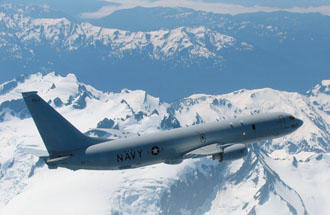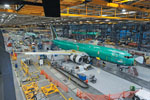Poseidon Rules the Waves From the Air
 |
The second P-8A flight test aircraft flies over mountains on its maiden flight in June. During the nearly three-hour flight, pilots performed a series of airborne systems checks before landing at Boeing Field near Seattle. |
The U.S. Navy is rolling out its first new maritime patrol reconnaissance aircraft in four decades, pushing mission technologies into the future. Upgrading the capabilities of the platform’s predecessor makes it better suited for today’s battle environment. Improvements include the ability to process more data, fly higher and longer and cover a larger area. The aircraft’s main purpose will be antisubmarine warfare, but it will be inherently flexible. In addition, the open systems architecture will make onboard adjustments easier and less expensive for the Navy and its partners while commercial production practices will reduce costs. Foreign nations and
Poseidon P-8A aircraft will replace the aging P-3C Orion fleet, which is reaching the end of its service life. The two platforms have many of the same technologies but with major upgrades on the Poseidon. For example, the radar on the newer aircraft is the next generation of that on the older one. The more modern electro-optical/infrared camera has an improved resolution of approximately 15 percent on the infrared side and 40 percent in the electro-optical function due to smaller focal plane array pixel size.
The Poseidon is a long-range antisubmarine warfare (ASW), anti-surface warfare, intelligence, surveillance and reconnaissance (ISR) aircraft that can accomplish broad-area maritime and littoral operations. According to Capt. Leon Bacon, USN, P-8A team lead, Program Manager AIR 290, under the U.S. Naval Air Systems Command, submarines are definitely a threat on which the Navy must focus. He says other countries are building or purchasing extremely hard-to-find submarines, and the
The long time lapse between the roll-out of the Poseidon and the P-3C’s introduction into the fleet 40 years ago came as a result of budgetary discretion. Eventually, according to Capt. Bacon, the Navy realized it had to replace the Orion because of fatigue. “There really was no other way to achieve the mission set other than with a manned platform,” he explains. The nature of ASW and the real-time response requirements mandate a manned solution. The captain describes the P-8A as the Star Wars version of the same mission tools found on the P-3C, which is also a manned aircraft.
Poseidon will carry more sonobuoys, which are used to detect submarines, than its predecessor. The processing capability of the new platform is twice that of the current aircraft, enabling the Navy to sweep a wider expanse of water faster than it can today. The Poseidon can process 64 passive sonobuoys and 32 multi-static sonobuoys, and perform concurrent passive/active processing. The Orion can process only 32 passive or 16 active buoys. Poseidon also will use auto-detection algorithms and has standard agreement (STANAG)-compliant digital recording as well as a sonobuoy positioning system.
The aircraft will have INMARSAT connectivity, chat capability and access to the secret Internet protocol router network. It also will accommodate Link 11, Link 16, communications across the spectrum from the high frequency through the Ku bands, satellite communication and a common datalink to downlink real-time video to ship or shore stations. The architecture will provide clear and encrypted communication capabilities to all crew members. The heart of all the capabilities is the mission computing and display system, which will provide the processing interface and secure connective infrastructure to unify the subsystems.
Other technologies will include increased electronic support measures and an early warning self-protection system composed of an integrated collection of components: AAR-54 missile warning sensors, an AAQ-24 directed infrared countermeasures system (DIRCM), an ALE-47 countermeasures expendable dispenser and an ALQ-213 system controller. The Poseidon also has an AN/APY-10 radar developed for the aircraft. The radar is the only system of its type to provide ultra-high-resolution imaging modes for maritime and overland operations. When the P-8A reaches initial operating capability, crew members will be able to control the tactical employment of unmanned aerial vehicles from it.
Poseidon can perform ASW and ISR functions up to a ceiling of 41,000 feet, almost 13,000 feet higher than the Orion’s 28,300 feet ceiling. This higher altitude will enable the Poseidon to support operations in the mountainous regions of
The platform will reach a maximum speed of 490 knots, compared to the 411-knot maximum speed of the Orion. It also will have a greater range, being able to traverse 1,200-plus nautical miles, stay on station for four hours and return versus the Orion’s range of 2,380 nautical miles total with three hours on station. Poseidon will have an in-air refueling capability to increase mission length without returning to station. Orion does not accommodate in-air refueling.
In addition, Poseidon will be able to obtain information from sensors and then directly launch a weapon if necessary because it will have all the capabilities needed to complete the sensor-to-shooter chain. The P-8A can act not only as an individual platform but also as a command and control asset for fleet and ground force commanders. According to Fred Smith, Boeing P-8A business development senior manager, the many capabilities of the Poseidon mean it will be as relevant in peacetime for missions such as anti-piracy and anti-terrorism as it will be in times of increased conflict.
Boeing leads the industry team building the P-8A for the Navy. Other team members are CFM International, Northrop Grumman, Raytheon, GE Aviation and Spirit AeroSystems. The Poseidon is being constructed using an inline process at the Boeing Company facility in
The inline process saves time and money versus the usual construction process of building a commercial aircraft and then cutting it into pieces to add the military components. After adding military components, workers using the traditional method have to reinforce the airplane. James Detwiler, Boeing P-8A business development international manager, explains that all the parts and pieces, such as the 11 weapons stations, of the Poseidon will be ordered and put together on the production line.
 |
Boeing’s team works to complete final assembly of the first two P-8A Poseidon flight test aircraft. The first ground test aircraft (back right) awaits the start of static testing. The team is using a first-in-industry inline production process and Boeing’s existing next-generation 737 production system to design and build the P-8A. |
Poseidon and the Orion both accommodate 11 crew members, but in the Poseidon all the workstations can support any operation, as opposed to the Orion, which has separate stations dedicate to specific functions. In the P-8A, flight commanders can rearrange their personnel’s locations based on the information they need during a particular operation. “That is a huge improvement just from a situational awareness standpoint,” Capt. Bacon says. “The displays themselves can fuse a common operating picture of what’s going on within their domain.” The displays also can overlay, further enhancing situational awareness.
Poseidon’s open systems architecture will allow it to prepare for the future in the present. “In the long run, Poseidon is important because we’ll be able to pace the threat,” Capt. Bacon says. He describes the aircraft’s systems as “not quite plug and play, but almost.” As new threats emerge, solutions to meet them can roll into the requirements process and be implemented in the following development increments.
Smith explains that open mission systems architecture allows for the rapid technical insertion of weapons and missions systems and includes future capacity for growth. He adds that with the open architecture, users have room for more technology and can make adjustments easily through software-only changes. “It’s a true multimission platform with emphasis on antisubmarine warfare,” Smith says.
The Navy already is preparing for anticipated upgrades in 2013, when the Poseidon reaches initial operating capability, and beyond. Aircrew will be trained the same year. In 2015, Increment 2 begins. That phase of development will enhance Poseidon’s situational awareness capabilities, combining its assets with cooperative commercial ships as the aircraft patrol different parts of the world. The various vessels can communicate via the Automatic Identity System, enabling Poseidon crews to concentrate on ships not participating in the system. Capt. Bacon explains that separating the wheat from the chaff makes it easier to track specific targets. Increment 3 occurs in 2018. That phase will focus on network-ready capability, but detailed upgrades and fleet integration are still being determined at this time.
The P-8A program completed the first flights of three test aircraft in 2009 and recently began the formal Navy flight test program in
The Navy has ordered 117 total aircraft, and the Indian Navy also has purchased eight P-8Is—the Indian variant of the P-8A. The P-8I will have the same structure and capabilities as the P-8A but will include some indigenous mission equipment as requested by the Indian Navy.
Other international customers are interested in the platform, including
The P-8A immediately will fill gaps left by the P-3C as the Navy retires the airplanes. The new aircraft will be located at the same locations—
WEB RESOURCES
Poseidon P-8A Overview: www.boeing.com/defense-space/military/p8a/index.html
P-3C Orion Fact File: www.navy.mil/navydata/fact_display.asp?cid=1100&tid=1400&ct=1



Comment
You didn't say anything about
It's plug & play, a U.S.B. P
Comments